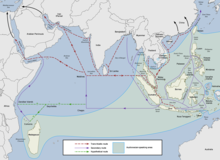
Back Θαλάσσιος δρόμος του μεταξιού Greek Ruta marítima de la seda Spanish Jalur Sutra Maritim ID 海のシルクロード Japanese മാരിടൈം സിൽക്ക് റോഡ് Malayalam Морской шёлковый путь Russian 海上丝绸之路 Chinese 海上絲綢之路 ZH-YUE

The Maritime Silk Road or Maritime Silk Route[2] is the maritime section of the historic Silk Road that connected Southeast Asia, East Asia, the Indian subcontinent, the Arabian Peninsula, eastern Africa, and Europe. It began by the 2nd century BCE and flourished until the 15th century CE.[3] The Maritime Silk Road was primarily established and operated by Austronesian sailors in Southeast Asia,[4]: 11 Tamil merchants in India and Southeast Asia,[4]: 13 and by Persian and Arab traders in the Arabian Sea and beyond.[4]: 13 China also started building their own trade ships much later, during the Song and Yuan dynasties from the 10th to the 14th centuries CE.[5][6]: 17
The network followed the footsteps of older maritime networks in Southeast Asia,[7][8][9][10] as well as the maritime spice networks of Southeast Asia, Sri Lanka, India, and the Indian Ocean, coinciding with these ancient maritime trade roads by the current era.[11][12]
Despite the modern name, the Maritime Silk Road involved exchanges in a wide variety of goods over a very wide region, not just silk or Asian exports.[6]: 17, 20, 149, 168 These goods include ceramics, glass, beads, gems, ivory, fragrant wood, metals (both raw and finished goods), textiles, food (including grain, wine, and spices), aromatics, and animals, among others. The goods carried by trade ships varied by region and port.[6]: 132–133, 186, 216
- ^ Manguin, Pierre-Yves (2016). "Austronesian Shipping in the Indian Ocean: From Outrigger Boats to Trading Ships". In Campbell, Gwyn (ed.). Early Exchange between Africa and the Wider Indian Ocean World. Palgrave Macmillan. pp. 51–76. ISBN 9783319338224.
- ^ Wang, Qiang (2020). Legendary Port of the Maritime Silk Routes: Zayton (Quanzhou). Qiang Wang. p. 280. ISBN 978-1-4331-7040-9.
- ^ "Maritime Silk Road". SEAArch.
- ^ a b c Cite error: The named reference
Guanwas invoked but never defined (see the help page). - ^ Flecker, Michael (August 2015). "Early Voyaging in the South China Sea: Implications on Territorial Claims". Nalanda-Sriwijaya Center Working Paper Series. 19: 1–53.
- ^ a b c Franck Billé; Sanjyot Mehendale; James W. Lankton, eds. (2022). The Maritime Silk Road (PDF). Amsterdam University Press. ISBN 978-90-4855-242-9.
- ^ Tsang, Cheng-hwa (2000). "Recent advances in the Iron Age archaeology of Taiwan". Bulletin of the Indo-Pacific Prehistory Association. 20: 153–158. doi:10.7152/bippa.v20i0.11751 (inactive 2024-04-12). ISSN 1835-1794.
{{cite journal}}: CS1 maint: DOI inactive as of April 2024 (link) - ^ Turton, M. (17 May 2021). "Notes from central Taiwan: Our brother to the south". Taipei Times. Retrieved 24 December 2021.
- ^ Everington, K. (6 September 2017). "Birthplace of Austronesians is Taiwan, capital was Taitung: Scholar". Taiwan News. Retrieved 24 December 2021.
- ^ Bellwood, Peter; Hung, H.; Lizuka, Yoshiyuki (2011). "Taiwan Jade in the Philippines: 3,000 Years of Trade and Long-distance Interaction". In Benitez-Johannot, P. (ed.). Paths of Origins: The Austronesian Heritage in the Collections of the National Museum of the Philippines, the Museum Nasional Indonesia, and the Netherlands Rijksmuseum voor Volkenkunde. ArtPostAsia. ISBN 978-971-94292-0-3.
- ^ Bellina, Bérénice (2014). "Southeast Asia and the Early Maritime Silk Road". In Guy, John (ed.). Lost Kingdoms of Early Southeast Asia: Hindu-Buddhist Sculpture 5th to 8th century. Yale University Press. pp. 22–25. ISBN 9781588395245.
- ^ Mahdi, Waruno (1999). "The Dispersal of Austronesian boat forms in the Indian Ocean". In Blench, Roger; Spriggs, Matthew (eds.). Archaeology and Language III: Artefacts languages, and texts. One World Archaeology. Vol. 34. Routledge. pp. 144–179. ISBN 978-0415100540.
© MMXXIII Rich X Search. We shall prevail. All rights reserved. Rich X Search